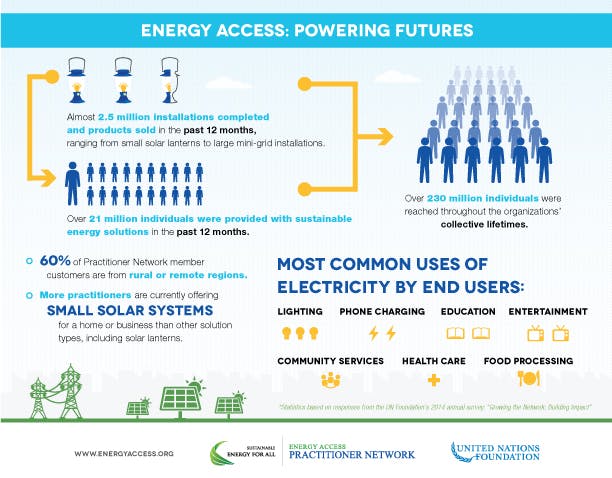The energy access gap
Energy access remains a significant challenge for many developing countries. According to the International Energy Agency (IEA) over 1.2 billion people today don’t have electricity. A billion more have power only intermittently. Lack of access to electricity limits critical aspects of education, health care and income generation.
Reaching universal energy access by 2030, one of three global objectives within the UN Secretary-General’s Sustainable Energy for All initiative, will be challenging, but is achievable. Under current scenarios, decentralized clean energy solutions – such as solar photovoltaic systems, small wind, small hydro, and micro-grids – will constitute around 60% of the solution and are most often provided by private sector and social enterprises. Grid electrification, generally the provision of governments, will constitute around 40% of the solution.
A global network bringing clean energy solutions to over 21 million people annually
To help meet this challenge, the UN Foundation in 2011 launched the Energy Access Practitioner Network as part of the Sustainable Energy for All initiative. It is a global network of businesses, civil society organizations, investors, governments, and academic institutions. Its mission is to help overcome fragmentation in the sector and catalyze energy service delivery, primarily through market mechanisms, by supporting knowledge sharing and peer learning, promoting new technologies and innovative financial and business models. It is technology and approach agnostic, focusing on access, affordability, quality and sustainability of solutions provided by its membership.
Since its initial launch, the Energy Access Practitioner Network has grown rapidly over three years to over 1,800 members based in 85 countries, and collectively operating in over 170 countries. According to the 2014 Energy Access Practitioner Network annual membership survey, responding members – representing over a quarter of the total network – collectively provided decentralized energy solutions to more than 21 million people in the last year.
Members value the Practitioner Network for providing a platform for mutual learning, facilitating partnerships, connecting finance with energy access entrepreneurs, information sharing, and facilitating greater visibility for their work.
Benefits of solutions provided at household and community level by members of the network include:
- Electricity for health care facilities to store blood and vaccines and power critical medical devices;
- Lighting for children to study after dark; and
- Improved safety of women and girls at night through solar street lighting.
And powering the agricultural sector using sustainable energy solutions such as solar water pumps and solar drip irrigation systems and providing power for milling helps to meet the growing demand for food production.
The Practitioner Network’s primary focus is on market-based approaches for rural electrification. More than 60% of the members are serving rural areas that traditionally have been hard to serve. Challenges include not only initial installation but also provision of effective maintenance of installed solutions over the lifetime of the asset.
The way forward
There has been tremendous growth in the sector since the Network’s establishment: Over the past year alone, members have completed over 2.5 million installations ranging from small products like solar lanterns to village level mini-grids. The sector is now rapidly scaling in certain markets, but barriers still remain. The number one challenge 75% of respondents reported in the survey remains access to the investment needed to help scale their businesses.
For the sector to reach its full potential and contribution toward achieving the goal of universal energy access, we must continue to highlight, help, and harness the full contributions of energy companies by providing them the tools they need to grow, to deliver solutions and services supporting families and communities, and to stimulate sustainable development.



 View All Blog Posts
View All Blog Posts